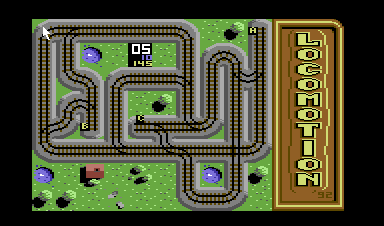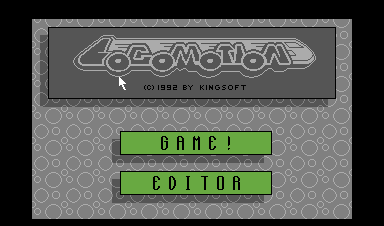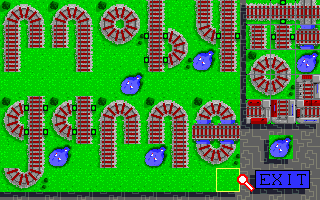Retro Replay Review
Gameplay
At its core, Locomotion delivers a tense, fast-paced puzzle experience that challenges your ability to think on the rails. You’re presented with a top-down view of a sprawling railway network dotted with stations and junctions. Trains emerge at random intervals from various origins, each clearly labeled with its destination station. Your primary task is simple in description but fiendish in execution: guide a set number of trains to their correct endpoints before the clock runs out, all while avoiding collisions and minimizing penalties.
(HEY YOU!! We hope you enjoy! We try not to run ads. So basically, this is a very expensive hobby running this site. Please consider joining us for updates, forums, and more. Network w/ us to make some cash or friends while retro gaming, and you can win some free retro games for posting. Okay, carry on 👍)
The heart of the gameplay revolves around toggling junctions with a single click of your cursor. Every time a train approaches an unset or misaligned switch, it barrels forward blindly, only coming to a halt if you intervene in time. Should a locomotive reach the wrong station, it dutifully reverses course, adding precious seconds to your timer and upping the tension. The risk of two trains meeting head-on forces you to balance quick reflexes with careful route planning—one misstep can send both trains to the scrapyard and rack up penalties that chip away at your final score.
Levels ramp up smoothly, introducing more complex track layouts, tighter time constraints, and a higher volume of trains in frantic succession. Early puzzles feel like a gentle tutorial, letting you get accustomed to the pace and mechanics. Before long, junctions multiply, tracks crisscross in intricate patterns, and split-second decisions determine whether you complete the level or watch your trains collide. The blend of strategy and arcade urgency keeps every session feeling fresh, testing both your spatial reasoning and nerve.
Graphics
Locomotion’s visual presentation is both functional and charming, opting for a clean, minimalistic style that places clarity above flashy effects. The top-down perspective offers a bird’s-eye view of the entire rail network, with tracks rendered in crisp lines and stations marked by distinct color-coded icons. Each train is tinted to match its destination, making it immediately obvious which junctions need toggling as soon as a locomotive appears on screen.
Animations are smooth and purposeful. Trains glide along track segments with convincing momentum, while switches rotate fluidly under your cursor’s command. When collisions occur or trains reverse at the wrong station, visual cues—such as sparks or subtle skid marks—convey the drama without cluttering the playfield. This restrained approach ensures you stay focused on the puzzle at hand, even when multiple trains converge in tight spaces.
The UI elements are intuitively laid out, with a timer and score counter discreetly placed at the top of the screen. Background art, often depicting rolling hills or city skylines in soft pastel hues, provides a pleasant backdrop without distracting from the main action. Overall, the graphics excel at delivering instant readability, letting you react quickly to emerging situations and keeping the hectic pace manageable.
Story
While Locomotion centers on puzzle mechanics rather than narrative depth, it still weaves a subtle thematic thread through its level progression. Early stages feel like humble suburban rail yards, with simple track loops and sparse junctions. As you advance, you traverse landscapes that evoke bustling industrial hubs and sprawling metropolitan systems, each new map hinting at the wider world of train travel beyond the puzzle grid.
The implicit storyline is that of an ever-growing rail network in need of a steady hand at the controls. There’s no voiced dialogue or elaborate cutscenes; instead, the “story” unfolds through increasing complexity and the unspoken satisfaction of running a tight, orderly railway. Level titles—ranging from “Countryside Express” to “Downtown Terminal”—add a dash of flavor and help you feel like a dispatcher climbing the ranks.
Though players seeking epic narratives won’t find classic storytelling tropes here, the game’s setting encourages a sense of progression and purpose. Each successful run feels like dispatching a flawless schedule, and every new junction arrangement hints at the next challenge. Locomotion proves that, sometimes, a well-crafted puzzle environment can evoke a narrative all its own.
Overall Experience
Locomotion stands out as a masterclass in arcade-puzzle design. Its straightforward control scheme—click to rotate junctions—belies deep strategic layers that emerge as you juggle multiple trains on increasingly crowded track networks. The satisfaction of guiding a perfect run is immense, while the penalty for mistakes keeps you on your toes and eager to retry. This addictive push-pull of tension and reward makes it ideal for both short pick-up sessions and marathon puzzle-binge afternoons.
Accessibility is another strong suit. Newcomers can jump right in thanks to the clear visuals and gradual difficulty curve, while puzzle veterans will appreciate the later levels’ complex track mazes and relentless train traffic. The game’s pacing strikes a sweet spot—it never feels unfair, yet it always demands your full attention. A simple misclick can send your meticulously planned sequence into chaos, ensuring every moment is alive with possibility.
In the realm of puzzle-arcade hybrids, Locomotion carves out its niche with elegant mechanics, crisp presentation, and an ostensibly minimalist approach that yields maximum engagement. Whether you’re a train enthusiast or simply someone looking for a brain-teasing challenge, you’ll find hours of replay value in mastering its switch-toggling ballet. It’s a testament to how a concise concept, polished to a shine, can deliver a deeply compelling gaming experience.
 Retro Replay Retro Replay gaming reviews, news, emulation, geek stuff and more!
Retro Replay Retro Replay gaming reviews, news, emulation, geek stuff and more!









Reviews
There are no reviews yet.